
* In the postwar period, the Cessna aviation company became famous for its popular line of civil aircraft, including prop singles and twins. Traditionally, Cessna prop singles had been of "taildragger" configuration, but in the mid-1950s Cessna introduced the "Model 182 Skylane", which was a derivative of the taildragger Cessna 180 but with fixed tricycle landing gear. The Cessna 182 led to the "Model 210 Centurion" derivative with retractable tricycle landing gear -- which led in turn to the "Model 205", which reverted to fixed tricycle landing gear. The Cessna 205 was followed by the refined "Model 206 Stationair 6" and then the stretched "Model 207 Stationair 8". This document provides a history and description of the Cessna prop "trikes" -- as well as the Cessna "Model 188" series of cropdusters.
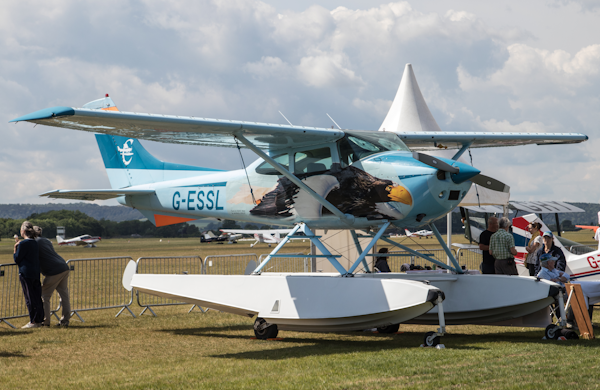
* In 1953 Cessna introduced the "Model 180 Skywagon" taildragger single, of all-metal construction, with:
It was the biggest Cessna single with fixed gear. The Skywagon proved popular -- one reason being that it was an excellent "bushplane", particularly when fitted with "fat" tires -- and so Cessna decided to make a tricycle version, with the "Model 182" introduced in 1956. The baseline Cessna 182 was almost identical to the baseline Model 180, except for fixed tricycle landing gear and an O-470L flat-six engine with 170 kW (230 HP), about 2% more power; it even had the same MTOW. Fuel capacity was 227 liters (60 US gallons). It was slightly slower than the Cessna 180 because of the drag of the (steerable) nose gear.
_____________________________________________________________________
CESSNA MODEL 182M SKYLANE:
_____________________________________________________________________
wingspan:
10.02 meters (32 feet 10 inches)
wing area:
16.16 sq_meters (174 sq_feet)
length:
8.55 meters (28 feet)
height:
2.71 meters (8 feet 10 inches)
empty weight:
715 kilograms (1,580 pounds)
MTO weight:
1,270 kilograms (2,800 pounds)
maximum speed:
270 KPH (165 MPH / 145 KT)
cruise speed:
190 KPH (120 MPH / 105 KT)
service ceiling:
5,760 meters (18,900 feet)
range:
1,575 kilometers (905 miles / 785 NMI)
_____________________________________________________________________
Pilots generally liked the tricycle landing gear, though it made the Cessna 182 less suitable for the bushplane role. There was also a problem in that pilots a tendency to touch down on the nose wheel, with the full weight of the aircraft causing the firewall to buckle. The firewall was reinforced, though pilots still had to be careful to perform "three-point" landings. Floats were often fitted for seaplane operation.
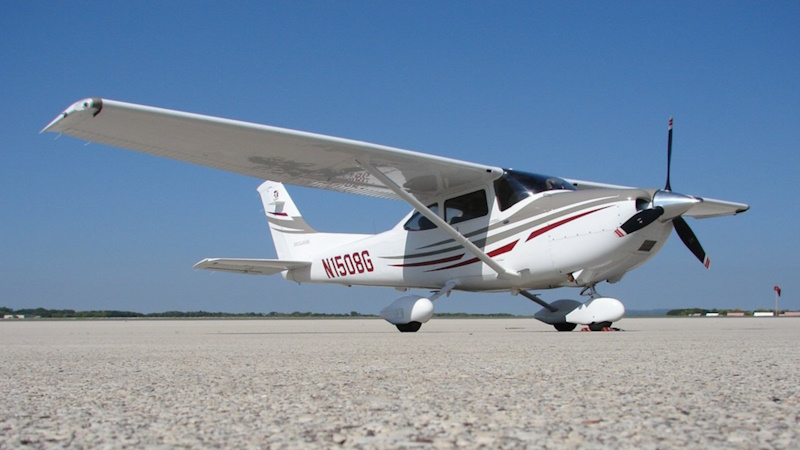
The baseline Model 182 was followed by refined variants:
Reims of France also produced a number of Model 182 variants as the "F182".

Sales of the 182 had been steadily declining, while there had been an uptick in liability claims -- with the result that Cessna stopped production of the Model 182 in 1986. However, in 1997 Congress passed a bill providing liability protection, and so in 1997 Cessna -- which had been acquired by Textron in 1992 -- put the Model 182 back into production as the "Cessna 182S". It was powered by a Lycoming IO-540-AB1A5 engine with 170 kW (230 HP) -- Lycoming then being another element of Textron, having been acquired in 1985. The Cessna 182S also had an updated electrical system, modernized avionics, and other small refinements.

The "Model 182T" was introduced in 2001, the primary change being an improved engine cowling providing better cooling and aerodynamics. A turbocharged option, the "T182T" was also offered, with TIO-540-AK1A engine with 175 kW (235 HP). A Garmin "glass cockpit" was offered from 2004, with a GPS navigation system offered from 2007. The Cessna 182T / T182T remains in production -- though with peculiar lapses in production, sometimes both being sold, sometimes one or the other. Over 23,000 Cessna 182s have been produced to date, many remaining in service. Many have been fitted with updates, particularly glass cockpits.
BACK_TO_TOP* By the late 1950s, the Cessna 182 had proven a success -- but Cessna didn't have an offering between the Model 182 and the Model 310 twin, in particular capable of competing with the Beech Bonanza. A "Model 185" prototype was flown in 1957, leading to the introduction of the "Model 210" in 1960. It was effectively a Cessna 182B with retractable landing gear, a modified wing with drooped wingtips, and a swept tailfin -- which was, of course, fed back into the Model 182C.
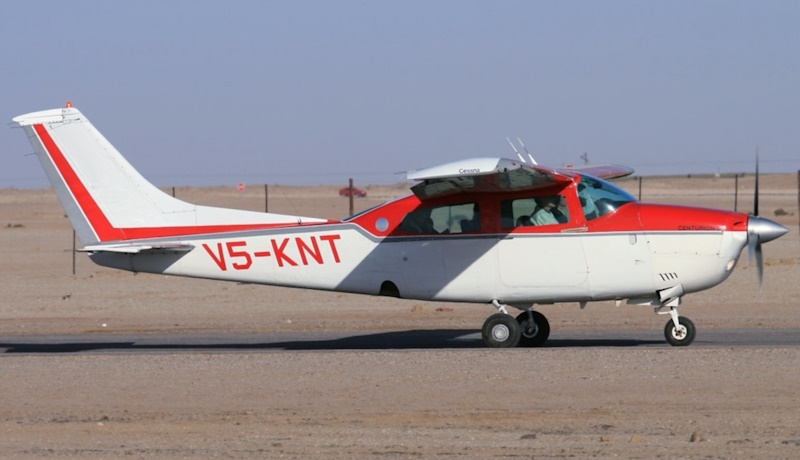
It introduced the characteristic Cessna landing-gear scheme, with the nose gear retracting forward, and the main gear retracting straight back into recesses on the rear fuselage; early on, the recesses had doors. Skis or floats, of course, were not very compatible with retractable landing gear. It was powered by a Continental IO-470-E engine with 195 kW (260 HP) and had two windows on each side of the fuselage.
_____________________________________________________________________
CESSNA MODEL 210J CENTURION:
_____________________________________________________________________
wingspan:
11.2 meters (36 feet 9 inches)
wing area:
16.36 sq_meters (176.1 sq_feet)
length:
8.61 meters (28 feet 3 inches)
height:
2.93 meters (9 feet 8 inches)
empty weight:
890 kilograms (1,960 pounds)
MTO weight:
1,540 kilograms (3,400 pounds)
maximum speed:
320 KPH (200 MPH / 175 KT)
cruise speed:
230 KPH (140 MPH / 125 KT)
service ceiling:
5,580 meters (18,300 feet)
range:
1,575 kilometers (905 miles / 785 NMI)
_____________________________________________________________________
Improved variants followed:
Cessna 210s have served in a number of military air arms in small numbers, for liaison, utility work, and training. Military users have included Bolivia, Dominican Republic, El Salvador, Honduras, Jamaica, Mexico, Philippines, Panama, & Paraguay.

As with the Cessna 182, production of the Cessna 210 series ended in 1986, with about 9,240 built. Unlike the Cessna 182, it never went back into production. Many remain flying, with updates available, such as glass cockpits, wingtip tanks, and alternative engine fits -- including turboprops.
BACK_TO_TOP* The Cessna 210 was, more or less, a Cessna 182 with retractable landing gear. Going full circle, in 1962 Cessna introduced for the 1963 model year what amounted to a Cessna 210 with fixed landing gear, originally designated "Cessna 210-5". It had six full-sized seats -- eliminating the retractable landing gear freed up the space for the rear seats -- and was powered by a Continental IO-470-S engine producing 190 kW (260 HP), with an MTOW of 1,500 kilograms (3,300 pounds).
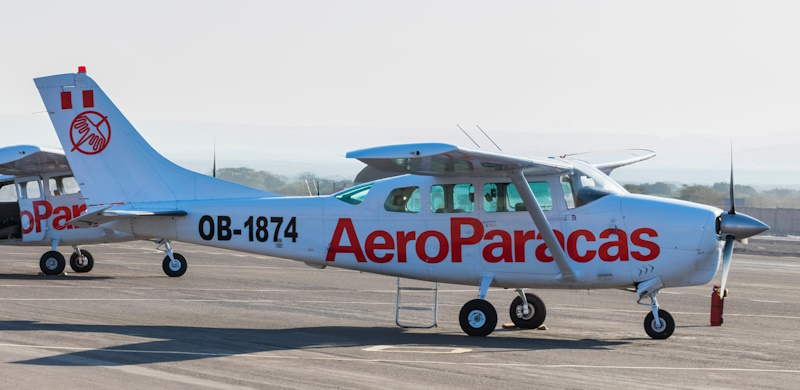
It could be fitted with floats, the floats raising the MTOW to 1,590 kilograms (3,500 pounds). In practice, oversized "tundra tires" could be fitted as well for bush operations, and skis could be fitted over the landing gear for snow operations. The baseline Cessna 205 led to the "Model 205A", for the 1964 model year, with only minor changes.
The "Model U206" -- "U" for "Utility" -- was introduced for the 1965 model year. It was effectively a generally refined Model 205, the most significant differences a double rear door on the right side of the cabin -- the doors hinged at the sides to open outward -- along with removeable seats, plus a Continental IO-520-A engine with 215 kW (285 HP). The doors could be removed for parachuting. It also removed the ugly bulge under the engine cowling. It was labeled the "Super Skywagon" after the Cessna 185, a popular utility machine. Weights were the same as for the Cessna 205.
A "Model P206" -- "P" for "Passenger" -- was built in parallel, the basic difference being six passenger seats and no cargo doors -- instead there being doors on the front of the cabin on left and right, instead of just one on the left, and a passenger door on the left rear of the cabin. It was labeled the "Super Skylane", after the four-seat Cessna 182; the passenger 206 variants wouldn't be as popular as the utility variants.
_____________________________________________________________________
CESSNA TU206A SUPER SKYWAGON:
_____________________________________________________________________
wingspan:
10.97 meters (36 feet)
wing area:
16.3 sq_meters (175.5 sq_feet)
length:
8.61 meters (28 feet 3 inches)
height:
2.83 meters (9 feet 4 inches)
empty weight:
985 kilograms (2,175 pounds)
MTO weight:
1,635 kilograms (3,600 pounds)
maximum speed:
280 KPH (175 MPH / 150 KT)
cruise speed:
260 KPH (165 MPH / 140 KT)
service ceiling:
4,800 meters (15,700 feet)
range:
1,350 kilometers (840 miles / 730 NMI)
_____________________________________________________________________
The "Model U206A & P206A" were produced for 1966, differing primarily in their MTOW being raised to 1,630 kilograms (3,600 pounds). Turbocharged versions were introduced as well, including the "TU206A" and "TP206A", both with a turbocharged Continental TSIO-520-C engine providing the same horsepower, but with better altitude performance. Further improved variants were then introduced:
The Model 206 went out of production in 1986 along with so many other Cessna aircraft. It was revived as the "Model 206H" for the 1998 production year, with a Lycoming IO-540-AC1A engine providing 225 kW (300 HP). The turbocharged "Model T206H" came back the next year, being powered by Lycoming TIO-540-AJ1A engine with 230 kW (310 HP). The Model 206 Series H remains in production, built with a Garmin glass cockpit from 2004.
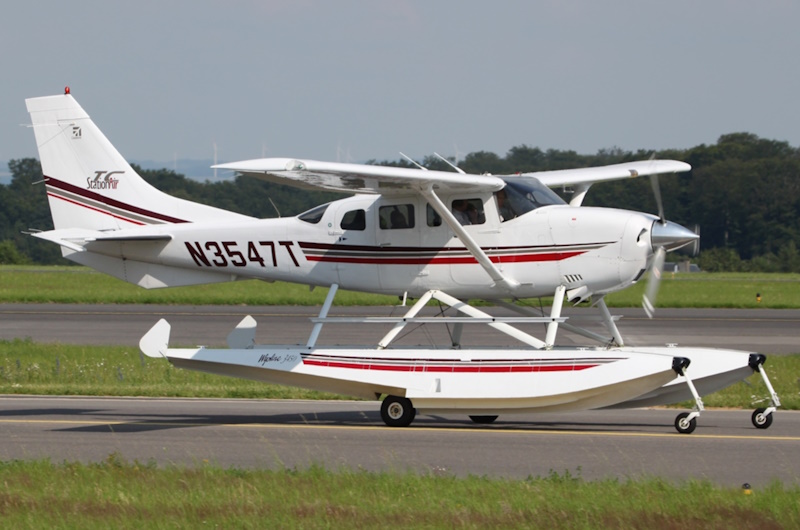
Many Cessna 206s remain flying, often having been given updates such as glass cockpits, uprated piston engines, and turboprops. One notably popular update is a belly pannier pack for more haulage space.
* The Model 206 led to the "Model 207", stretched by 1.14 meters (45 inches), with forward and rear extensions, to provide seven seats. Door arrangement remained the same, incidentally, though a nose baggage hold was added, courtesy of the fuselage stretch. It was introduced for the 1969 model year, being powered by a Continental IO-520-F engine of 220 kW (300 HP). MTOW was 1,725 kilograms (3,800 pounds). It could be fitted with floats. A turbocharged "T207" was produced in parallel, featuring a TSIO-520-G with the same power ratings. It was originally called the "Skywagon", changed in 1970 to "Stationaire 7".
_____________________________________________________________________
CESSNA T207 STATIONAIRE 7:
_____________________________________________________________________
wingspan:
11.15 meters (36 feet 7 inches)
wing area:
16.3 sq_meters (175.5 sq_feet)
length:
9.68 meters (31 feet 9 inches)
height:
2.87 meters (9 feet 5 inches)
empty weight (passenger seats removed):
985 kilograms (1,960 pounds)
MTO weight:
888 kilograms (3,800 pounds)
maximum speed:
305 KPH (190 MPH / 165 KT)
cruise speed:
250 KPH (130 MPH / 115 KT)
service ceiling:
7,375 meters (24,200 feet)
range (280 KPH at altitude):
980 kilometers (610 miles / 700 NMI)
_____________________________________________________________________
Camber-lift wings, which had a slightly cuffed leading edge, were added in 1972, improving low-speed handling with little performance penalty. The baggage compartment was also extended at that time. An aerodynamic cleanup in 1975 marginally improved top speed.
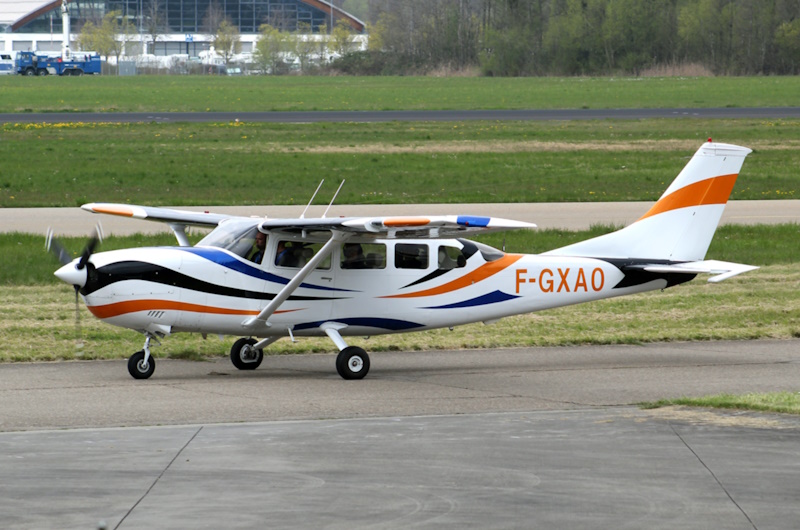
The "Model 207 Series A" was introduced for the 1977 model year, featuring minor improvements, and the T207A being given a TSIO-520-M engine with 230 kW (310 HP). It was renamed the "Stationair 7". In 1979, it was given another seat and integral wing tanks, to become the "Stationair 8". Production of the series ended in 1984, with 626 built. It was popular with air taxi companies, but not very popular with private fliers, few having use for the extra seats.
The Cessna 206 and 207 have served in small numbers with police, paramilitary, and military organizations of a number of countries, including Argentina, Bolivia, Canada, Chile, Costa Rica, Colombia, Djibouti, Dominican Republic, Ecuador, France, Guatemala, Guyana, India, Israel, Madagascar, Mexico, Pakistan, Panama, Paraguay, Peru, Philippines, Portugal, Suriname, USA, Uruguay, and Venezuela.
BACK_TO_TOP* The Cessna single-prop civil aircraft family also led to a successful agricultural aircraft, the "Model 188 AgWagon". It began life in the early 1960s, with Cessna talking to operators of existing agricultural aircraft to find out what they wanted. Initial flight of the prototype Model 188 was on 19 February 1965, with introduction in 1966.
As it emerged, the Cessna 188 was of stereotypical agricultural aircraft configuration, with a low-mounted wing with strong dihedral outboard and strut bracing, robust fixed taildragger landing gear, and a high-perched enclosed cockpit. The cockpit had a door on each side -- actually, more like large window panels that were hinged at the bottom -- and ventilation from the top, to help keep out chemical fumes. It was built of aluminum over a tube-steel frame, with a chemical hopper built of fiberglass and with a capacity of 760 liters (200 US gallons). Sealants were used to protect the pilot and the airframe from the chemicals. Although it was a new design, it inherited elements from the Cessna 180. Two variants were sold in parallel:
In 1968, both variants were given a set of small updates, most notably a bit of cabin pressurization to keep out toxic chemicals while spraying, and given updated the updated model numbers of "188A-230" and "A188A-300" respectively.
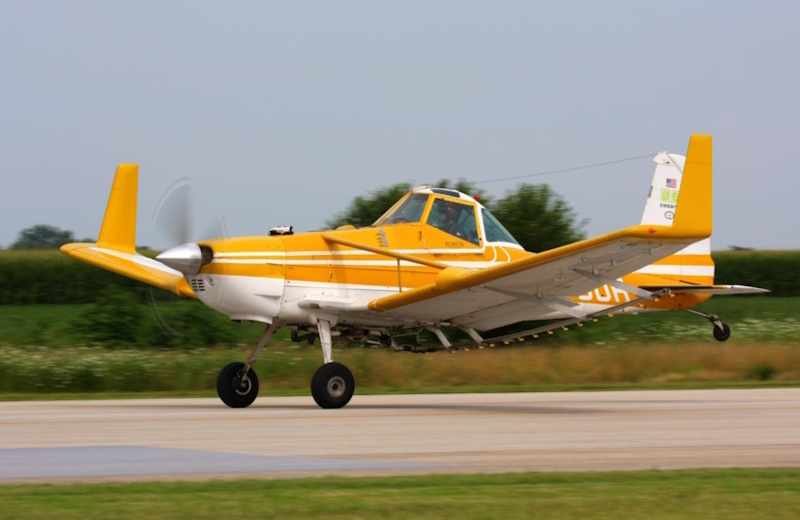
Another set of refinements, including cambered wingtips, was added in 1972, with the two variants becoming the "188B-230 AgPickup" and "A188B-300 AgWagon" respectively. An "A188B-300 AgTruck" was added to the line at that time, with a bigger 1,060-liter (280 US gallon) hopper, and option for a three-bladed prop. The AgPickup was dropped from production in 1976, with the AgWagon following it down in 1981. The very last Model 188 variant, introduced in 1979, was the "T188C AgHusky", like the AgTruck but with a Continental TSIO-520-T turbocharged engine providing 230 kW (310 HP), driving a three-bladed variable-pitch prop.
_____________________________________________________________________
CESSNA 188B-300 AGTRUCK
_____________________________________________________________________
wingspan:
12.7 meters (41 feet 8 inches)
wing area:
19 sq_meters (205 sq_feet)
length:
8 meters (26 feet 3 inches)
height:
2.35 meters (7 feet 8 inches)
empty weight (no dispersal gear):
935 kilograms (2,060 pounds)
MTO weight:
1,905 kilograms (4,200 pounds)
maximum speed:
195 KPH (120 MPH / 105 KT)
cruise speed:
180 KPH (115 MPH / 100 KT)
take-off distance (to 15 meters / 50 feet):
330 meters (1,090 feet)
landing distance (from 15 meters / 50 feet):
385 meters (1,265 feet)
service ceiling:
3,400 meters (11,100 feet)
range (280 KPH at altitude):
475 kilometers (295 miles / 255 NMI)
_____________________________________________________________________
One of the interesting little factoids about the Model 188 was that when spray bars were fitted, the spray was driven by a little spinner prop between the main gear struts.
A total of 3,976 Cessna 188s was built, including 53 AGpickups, 1,589 AGwagons, 1,949 AGtrucks, and 385 AGhuskies. They were mostly flown for agricultural work, but some were put to use as sailplane tugs. Many remain in service.
BACK_TO_TOP* Sources for this document include the online Wikipedia, Cessna Owner's Association, various air encyclopedias, and volumes of JANE'S ALL THE WORLD'S AIRCRAFT. It is hard to get much background on light civil aircraft.
* Illustration credits:
* Revision history:
v1.0.0 / 01 apr 24 / gvg (+)BACK_TO_TOP
